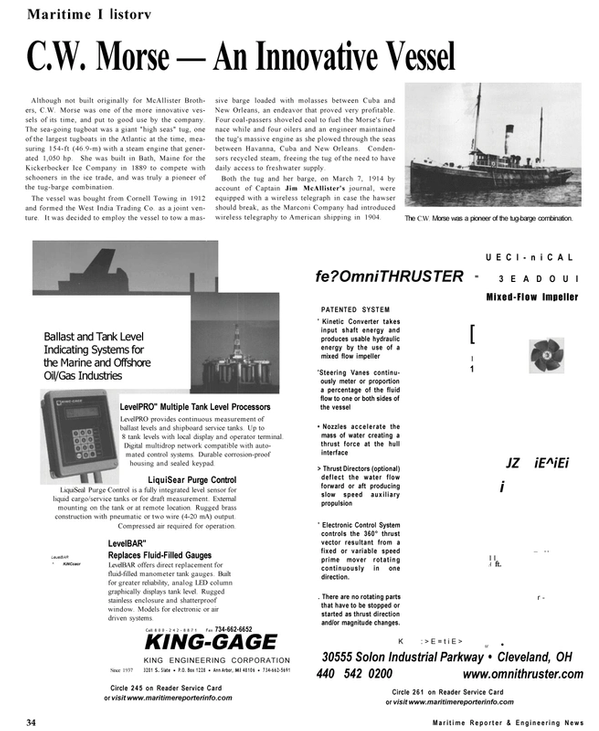
C.W. Morse — An Innovative Vessel
Although not built originally for McAllister Brothers, C.W. Morse was one of the more innovative vessels of its time, and put to good use by the company.
The sea-going tugboat was a giant "high seas" tug, one of the largest tugboats in the Atlantic at the time, measuring 154-ft (46.9-m) with a steam engine that generated 1,050 hp. She was built in Bath, Maine for the Kickerbocker Ice Company in 1889 to compete with schooners in the ice trade, and was truly a pioneer of the tug-barge combination.
The vessel was bought from Cornell Towing in 1912 and formed the West India Trading Co. as a joint venture.
It was decided to employ the vessel to tow a massive barge loaded with molasses between Cuba and New Orleans, an endeavor that proved very profitable.
Four coal-passers shoveled coal to fuel the Morse's furnace while and four oilers and an engineer maintained the tug's massive engine as she plowed through the seas between Havanna, Cuba and New Orleans. Condensors recycled steam, freeing the tug of the need to have daily access to freshwater supply.
Both the tug and her barge, on March 7, 1914 by account of Captain Jim McAllister's journal, were equipped with a wireless telegraph in case the hawser should break, as the Marconi Company had introduced wireless telegraphy to American shipping in 1904.
Read C.W. Morse — An Innovative Vessel in Pdf, Flash or Html5 edition of September 2001 Maritime Reporter
Other stories from September 2001 issue
Content
- More Muscle for a Distinctive Breed page: 8
- A Shipboard Gantry Crane History page: 9
- Standards for A New Era page: 10
- Gladding-Hearn Delivers Premiere High Speed Passenger Cat page: 12
- Austal USA Readies 82-ft. Cat For Spring 2 0 0 2 Delivery page: 12
- A&B Industries Delivers Model-Bow Tug To Luhr Bros page: 14
- Morrelli and Melvin Teams Up With Knight And Carver page: 14
- Moran Commissions 10th Z-Drive Tug page: 15
- Sealift Ship To Be Christened Benavidez At Avondale Shipyard page: 15
- Commerce page: 18
- Shipping Industry Launches Ship Recycling Code page: 19
- Strategic Launches Shipping Support Tools page: 19
- Barge Management System Increases Efficiency page: 20
- Chiles Offshore Signs Two 9-Month Contracts With Shell page: 21
- Super Barge Touted For Strengths, Depths page: 24
- After 137 Years—A Legacy Prevails page: 26
- Maritime History page: 28
- Entering the Diesel Engine Age page: 31
- Janet M. McAllister Debuts In N.Y. Harbor page: 32
- C.W. Morse — An Innovative Vessel page: 34
- SCI Dedicates Houston Facility page: 37
- Gdansk Shipyard Leads With Myriad of Conversions/Repairs page: 38
- Hyundai, MAN B&W Are At Top of Engine Power page: 40
- Axial Fans Improve Engine Performance page: 48
- Rolls-Royce Debuts New Thruster Range page: 48
- Custom Thruster Solutions Help Save Time, Money page: 49
- Marine Training Via Simulation: As Real as it Gets page: 50
- KMSS Supplies Unit To Lairdside Maritime Center page: 51
- Litton's ECDIS Products Are N o w Compatible With C-MAP's ECs page: 60


